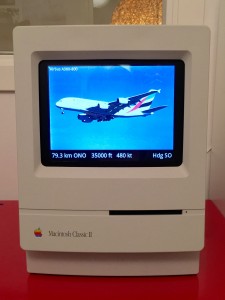This is a followup to my previous post about bringing life back to an old Macintosh Classic II.
Having an iconic Mac with a Raspberry Pi inside doing nothing is kind of dull. I wanted the Classic to display something interesting (at least in my point of view) and I did have another Raspberry Pi in the attic receiving ADS-B data and posting to an MQTT feed. How about showing a picture of the nearest aircraft with information about its speed, heading, altitude, distance, bearing and so on?
Without diving too much into the details about ADS-B, what we get from the aircraft is basically speed, heading, altitude and a 24 bit identification number, the icao24. This is a globally unique aircraft ID registered with the International Civil Aviation Organization and we somehow need to convert this into an actual image of the aircraft.
The aircraft’s operator, type and registration are not available in the ADS-B data the aircraft transmits and needs to be pulled from another data source. One excellent source is PlaneBaseNG with about 147k aircrafts. The database consists of an SQLite database which serves us well. Once we have the aircraft type and operator we make a Bing image search and pull an image of suitable size.
The system architecture looks like this, with data flowing from top to bottom
ADS-B receiver
ADS-B client
Proximity radar
Skygrazer
The ADS-B receiver is a Raspberry Pi with an RTL dongle running dump1090.
ADS-B client is a Python script parsing data from dump1090’s feed on port 30003, converting it into a JSON object, adding aircraft data from PlaneBase and publishing on the MQTT topic “`/adsb/radar/json“`.
Proximity radar is another Python script subscribing to “`adsb/json“` while keeping track of which aircraft is the closest one. It calculates distance and bearing, performs image lookup and publishes on the MQTT topic “`adsb/proximity/json“`.
Skygrazer is an application written in SDL2 subscribing to the topic “`adsb/proximity/json“` that downloads and displays the image and flight data received.
The architecture might seem like an overkill but I like the publish/subscribe idea of MQTT, it is a bit like Unix commands. Each one performing one task (and performing it well) and several commands may be chained to create something bigger that the sum of its parts. It also lends itself well to other ideas I have of how to have fun with ADS-B data.
Here is an image of the Classic in action with an A380 from Emirates passing by.

The project turned out nicely. The Classic runs 24/7 and since the airspace over the southern tip of Sweden is quite busy there is always something going on. I have almost gotten to know some of the aircrafts and flights around here. A quick glance on the Classic and I can tell I am looking at the Air France A380 from Charles de Gaulle to Tokyo. Nerdy huh?
Update! Checkout further use of the ADS-B data in “Commercial pilots control my moonlight“.